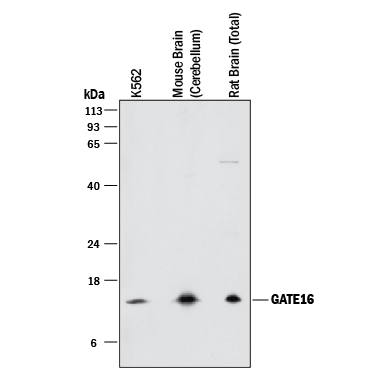Human/Mouse/Rat GATE-16 Antibody Summary
Accession # P60520
Applications
Please Note: Optimal dilutions should be determined by each laboratory for each application. General Protocols are available in the Technical Information section on our website.
Scientific Data
 View Larger
View Larger
Detection of Human, Mouse, and Rat GATE-16 by Western Blot. Western blot shows lysates of K562 human chronic myelogenous leukemia cell line, mouse brain (cerebellum) tissue, and rat brain (total) tissue. PVDF membrane was probed with 2 µg/mL of Rat Anti-Human/Mouse/Rat GATE-16 Monoclonal Antibody (Catalog # MAB9035) followed by HRP-conjugated Anti-Rat IgG Secondary Antibody (Catalog # HAF005). A specific band was detected for GATE-16 at approximately 15 kDa (as indicated). This experiment was conducted under reducing conditions and using Immunoblot Buffer Group 1.
Reconstitution Calculator
Preparation and Storage
- 12 months from date of receipt, -20 to -70 °C as supplied.
- 1 month, 2 to 8 °C under sterile conditions after reconstitution.
- 6 months, -20 to -70 °C under sterile conditions after reconstitution.
Background: GATE-16
Golgi-associated ATPase Enhancer of 16 kDa (GATE-16), also known as Apg8p2 and GABARAPL2, is a 117 amino acid (aa) polypeptide and a member of the Autophagy-related 8 (Atg8) family of proteins (1). GATE-16/Apg8p2 has 100% aa sequence identity with its mouse and rat orthologs, and is orthologous to the yeast Atg8. Atg8 family members show structural similarity with Ubiquitin, but lack aa sequence similarity. GATE-16/Apg8p2 is best known for its role in autophagy (2,3). GATE-16/Apg8p2 covalently attaches to phosphatidylethanolamine (PE) the phagophore (autophagosome precursor) membrane using a Ubiquitin-like conjugation system that includes Ubiquitin-activating (E1)-, Ubiquitin-conjugating (E2)-, and Ubiquitin Ligase (E3)-like enzymes. Here it is involved in the later stages of autophagosome formation (4,5). It may also be involved in cargo recruitment to autophagosomes (1).
- Shpilka, T. et al. (2011) Genome Biol. 12:226.
- Wang, H. et al. (1999) Nature 397:69.
- Leil, T.A. et al. (2004) J. Neurosci. 24:11429.
- Weidberg, H. et al. (2010) EMBO J. 29:1792.
- Weidberg, H. et al. (2011) Ann. Rev. Biochem. 80:125
Product Datasheets
FAQs
No product specific FAQs exist for this product, however you may
View all Antibody FAQsReviews for Human/Mouse/Rat GATE-16 Antibody
There are currently no reviews for this product. Be the first to review Human/Mouse/Rat GATE-16 Antibody and earn rewards!
Have you used Human/Mouse/Rat GATE-16 Antibody?
Submit a review and receive an Amazon gift card.
$25/€18/£15/$25CAN/¥75 Yuan/¥1250 Yen for a review with an image
$10/€7/£6/$10 CAD/¥70 Yuan/¥1110 Yen for a review without an image

